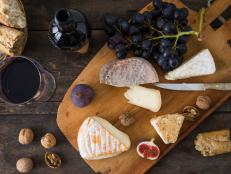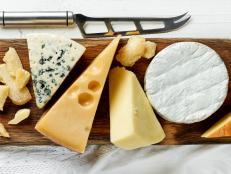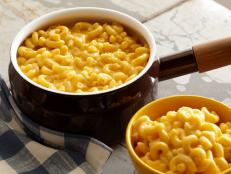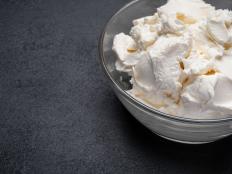The Secret to a Perfect Cheese Tray
Salami river optional (but highly recommended).
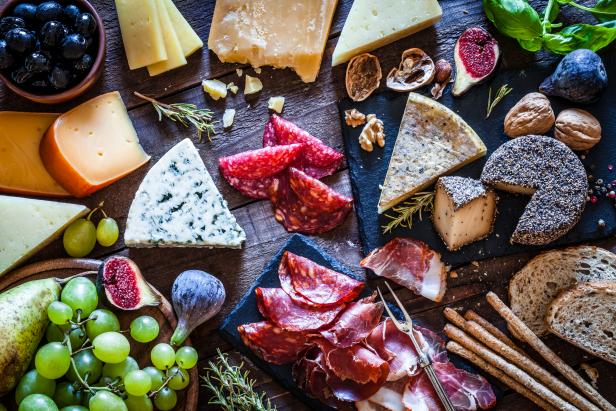
fcafotodigital
Few sights can rival the oohs and ahhs that a cheese tray elicits, whether you’re at a dinner party, holiday shindig or in your own kitchen (hello, weeknight cheese plate). But there’s more to creating an interesting and vibrant cheese tray than unwrapping a few wedges and plopping them on a repurposed slab. Here, seasoned cheese pros share their favorite tips to ensure that your cheese tray is as gouda as it gets.
Marissa Mullen, founder of That Cheese Plate and author of the forthcoming That Cheese Plate Will Change Your Life, has earned a following for her Instagram-worthy fromage assembly, so naturally, she has a lot of thoughts.
"Cheese is the focus for the entire plate, acting as the foundation to build upon for pairings and aesthetics. I'll usually pick three to four different styles of cheese to provide a variety on the plate," Mullen says. "This can be one soft cheese (Brie), one hard cheese (Gruyere), one stinky cheese (blue) and one sharp cheese (cheddar)—but it really depends on what you're feeling in the moment." Ina’s Easy Cheese Board or her All-American Cheese Board are both a great place to start.
To transform the variety of textures and flavors on the plate, Mullen suggests varying your cheeses based on the type of milk — cow, goat and sheep — or incorporating a blend of local and European cheeses. If you don’t have access to a wide selection, look for different shapes like round, square or wedges, which will help add variety once the cheeses are cut. (Mullen recommends cutting hard cheeses ahead of time to ensure easy grazing for guests.)
Lindsey Schechter, who owns specialty cheese shop Houston Dairymaids, agrees that variety is key. In addition to aesthetics, a range of styles, milk types and flavors helps accommodate a variety of palates. Schechter also advises adding color when possible, incorporating cheeses made with orange-red annatto, or one with a rind treatment like pimenton-rubbed Spanish cheeses. Your cheese monger should be able to put together a nice selection that’s within your budget, but some holiday-ready limited-edition cheeses can be worth the splurge (especially bark- or leaf-wrapped cheeses that double as centerpieces).
Once you have an approach to types, the next big question is: How much cheese do you need? Will Ashe, executive chef of Inn on the Square in Greenwood, South Carolina, believes that less is more. At home, he recommends aiming for three assorted cheeses and planning for one ounce per person (cheese shops or grocery store cheese departments will usually cut to order). If you’re planning to serve a lot of other food, Schechter suggests dialing the per-person serving back to a half-ounce.
With cheeses selected and purchased, it’s time to focus on assembly. A wooden cutting board or a slate are both great options for the tray itself, for example this swivel board that earns raves online. Ashe likes to up the ante by using a mirror for special events. It’s unexpected and dramatic, and the reflection better shows off the cheeses’ textures (provided you leave space in between the cheeses).
There are also considerations for where to put which cheeses. “While building a display, you want to keep your milder cheeses in front and bolder flavors in the back. Soft cheeses always to start, blue vein [cheeses] on the right side,” Ashe advises. “When we place the blue cheese to the right, we find the crumbles tend to get pushed away from the other cheeses — most people cut and serve with their right hand — rather than tumbling back toward the main part of the tray and contaminating the milder cheeses.”
If you’re hosting a large crowd, Mullen says it may be helpful to label the cheeses with the name, type of milk and perhaps a descriptive word like buttery, sharp or nutty. For more intimate gatherings, she prefers leaving them unlabeled to invite conversation as hosts talk guests through the cheese selections and possible pairings.
Speaking of pairings, you’ll need to consider what you serve alongside the cheese. Mullen likes to place her cheeses in the corners of the tray or board, then follows the steps from her Cheese By Numbers guide to build a balanced and bountiful plate.
“Charcuterie is a great pairing to any cheese. I like to make what I call the ‘salami river,’” Mullen says. “Fold pieces of Genoa salami (or prosciutto) and place flowing down the middle of the plate, from one side to the other. This gives your plate some artistic feel. Pre-folding meat also makes it easy for guests to pick up individual slices.”
Mullen considers produce another key addition. Not only does it add pops of color, but most produce has a neutral flavor profile that makes it ideal for pairing with cheese. Mullen suggests making small piles of produce around the plate, grouping fruit on one side of the salami river and veggies on the other. For a holiday theme, Mullen imagines pulling in fruit such as pomegranates, dried apricots, cranberries and apples.
Next, Mullen says considering crunch is key. She sprinkles crackers or bread and nuts among the gaps on the plate, then keeps a cracker plate on the side for easy replenishment. If you have a smaller cheese tray, consider serving nuts, bread or crackers on the side. Schechter says that a crusty baguette is perfect for most cheeses, especially gooey vacherin-style logs which appear at holiday time. If you go the cracker route, opt for plain crackers without too much salt. As far as nuts go, consider serving roasted nuts to highlight certain cheeses’ nutty notes. (Follow this easy primer for toasting nuts.) Ashe says that another way to add crunch is to add dried fruit chips to the mix.
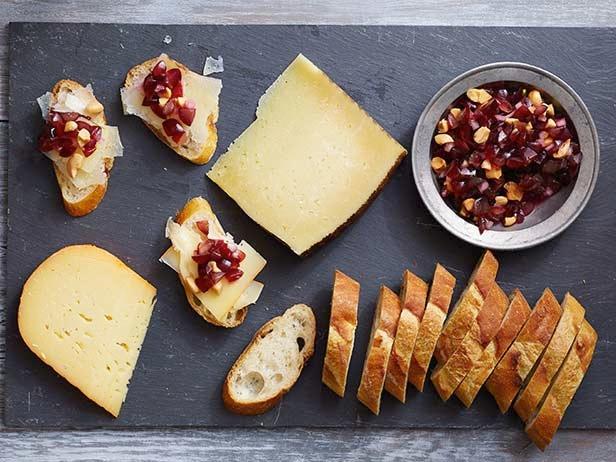
Anna Williams
Accompaniments such as jam, chutney, honey and mustard are common cheese tray pairings. Mullen is a fan of serving them as dip in a ramekin or small bowl on the board. Up the ante and make your own: try Giada’s homemade fig jam, Sunny’s Apple Compote, an easy five-ingredient pear chutney or this grape tapenade (pictured above). For the final touch, Mullen recommends sprucing up the cheese plate with garnishes such as fresh herbs like rosemary and thyme.
For more inspiration, read our How to Set Up a Cheese Plate tutorial, or try one of these theme-ready boards: This Beer and Cheese Party Plate favors bold flavored cheeses paired with spiced nuts, while this kid-friendly Family Night Cheese Plate is tailor-made for snacking during board game night.
Related Links:
Fall Entertaining Guide

























